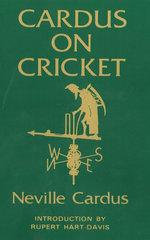Cardus on Cricket
David Taylor |Published: 1977
Pages: 256
Author: Cardus, Neville
Publisher: Souvenir Press
Rating: 4 stars

Not long ago we were discussing one of the sacred cows of cricket writing, CLR James, and here we have another. Neville Cardus was born in 1888 in Manchester, into desperate poverty, but became known as a peerless writer on cricket and classical music, eventually receiving a knighthood a few years before his death in 1975. The following years’s Wisden did not include an obituary of Sir Neville, but carried the text of Alan Gibson’s address at his memorial service instead. It was assumed that all readers would know who he was. He wrote for much of his working life for the Manchester Guardian, as it was then known, but also for other newspapers and produced a number of acclaimed books. Although his output slowed in his last years he was contributing to the famous almanack well into the 1960s.
I wasn’t that familiar with his work until recently, having only read Australian Summer, his account of the MCC tour of Australia in 1936-37, but now I have plenty more with the arrival of these two anthologies. The publishing credits on both paperbacks are a little vague, it has to be said. Cardus on Cricket has a credit ‘first published in 1949’ and ‘this edition/reprinted 1977’. A Fourth Innings with Cardus has the credits ‘copyright 1981’ (six years after the writer’s death) and ‘reprinted 1987’. These appear to be further reprints by the London-based Souvenir Press. Further information is not readily forthcoming. The first book carries the cover credit ‘introduction by Rupert Hart-Davis’ – the publisher and editor who himself died in 1999 – and contains the introduction to the 1949 edition, which takes the form of a short account of Cardus’s life, or at least the first sixty years of it. That much is useful, as is the contents list listing five books and the pieces taken from them (there are also a couple from the Guardian). A Fourth Innings … is a collection of newspaper and magazine pieces, and again these are listed in the Contents, as you would hope. They originally appeared in the Gurdian, the Sunday Times and the Spectator.
So much for the packaging. What of the contents? The adjectives most often used to describe Neville Cardus’s writing are romantic, nostalgic, poetic, whimsical. His style takes a little getting used to, but he is not difficult to read. Perhaps a couple of examples are called for; here he is writing of England captain of the 1920s, Percy Chapman:
Here we are at the crowning glory of Chapman’s cricket – it is the cricket of youth. He looks the young cricketer all over – tall, sturdy, pink-cheeked, and fair of hair. He goes to the crease like one in search of adventure. The good ball that baffles him and just misses his wicket does not dismay him; he invariably has a smile for the bowler, and larger impudence for the next ball.
And a little later on the scourge of England bowlers in the 1930s:
At Leeds Bradman announced his right to mastership in a few swift moments. He made 72 runs during his first hour at the wicket, giving to us every bit of cricket except the leg glance. But long before he got near the end of his innings he was repeating himself; it was as though the sheer finish of technique was a prison for his spirit. He could not make a hazardous flight; he reminded me of the trapeze performer who one night decided to commit suicide by flinging himself headlong to the stage, but could not achieve the error because his skill had become infallible, a routined and mechanical habit not at the beck and call of anything so volatile as human will or impulse.
Reading those two sections should give you a pretty good idea of whether Cardus is for you or not. He was writing these pieces more than three-quarter of a century ago, of course, and readers then would have been used to a rather more flowery style than we would normally come across today. While I can see that he isn’t going to be to all tastes I found the books a delight to read – every word carefully chosen, phrases put together with loving care for the English language, never talking down to the reader, perhaps always mindful of his own humble roots. His affection for the cricket and the cricketers of the northern counties makes many of these pieces (the Yorkshire bowler Emmott Robinson is supposed to have once claimed to him, “Mester Cardus, tha invented me”), but he is not so parochial that he can’t appreciate the good play and personal qualities of others, Australians, West Indians, even southeners.
Is the time ripe for a Cardus revival? Probably not, he is read a good deal less, I suspect, than he was thirty years ago; as new writers achieve prominence they inevitably attract the casual reader first. But anyone wishing to look back to a gentler and less pressurised and money-driven time will find plenty to enjoy here.






The fact that I’m reading this, a review released in 2013, about a book published in 1977, is surely a testament to how timeless Cardus and CricketWeb are!!
I have to bring up tho, there’s a typo, on the last line of the second paragraph. But considering it was nicknamed the Grauniad, I reckon it still checks out?
Thanks again for the reviews and please bring back the books of the year format!!
Cheers
Sid
Comment by Sid | 7:12pm BST 27 July 2022